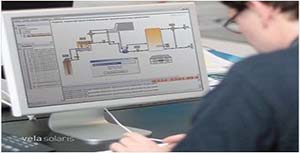Greetings!
In response to you requesting information on Solar Hot Water Products, we hope you will find these newsletters useful. The theme of these newsletters will be to help you understand how solar works, how the systems are sized and how to calculate how many panels you need, how to calculate the pressure loss and how to size pump stations etc. Every few weeks or so we will pick a new topic.
In this issue, some Solar History and Why Evacuated Tube Collectors are the way to go for Canada. Also Solar Insolation, What is it and how is it measured?
We have just moved our contact list to a more advanced system to help manage the volume of request for information. It will also help those of you who no longer wish to receive information on the Solar Systems. If you no longer wish to receive a news letter such as this please follow the "newsletters" link at the bottom of this email.
The History of Solar Energy - Why Evacuated Tube Solar Collectors work so well.
History of Solar Collectors
Obviously solar energy comes from the sun, but how do we capture it.
Back in about 1767 a scientist Horace de Saussure created the worlds first Solar Oven. This consisted of 3 layers of glass surrounding a well insulated box. Sunlight passed through the glass heating up the box and the layers of glass trapped the heat in. This was in effect probably the first Solar Collector.
The highest temperature recorded was 230 degrees F. He also repeated the experiments at the top of a mountain, 4852ft higher up and found the exact same temperatures. The dual layer of glass in the solar vacuum tubes trap the heat and it does not matter how cold it is outside. It can be -40 Deg C outside and the collectors work just as efficiently as they do in the summer but the shorter daylight hours will reduce the amount of sunlight you get.
Therefore, Evacuated tube solar collectors work so well in cold Canadian climates, they have 2 layers of glass separated by a vacuum to maximize the insulation. Flat Plate Solar Collectors only have a single layer of Glass (and no vacuum) insulating the heat inside from the cold outside, this is why when the temperature falls in winter, they lose huge amounts of heat back outside which makes them much less efficient. If you live in Hawaii or Florida, then Flat Plate collectors work more efficiently. They have only one layer of glass which means more Solar Radiation gets through, but it does not get cold in winter, so you do not need the insulation of the Vacuum tube collectors.
The Evacuated tube solar collectors will keep getting hotter and hotter until they reach a stagnation temperature which in the case of Evacuated Tube Solar Collectors can be over 300 Degrees F, much hotter than the Flat Plate collectors will. It is for this reason Evacuated Tube Type Collectors are also very useful in commercial applications.
Back in the 1890s solar water heaters were being used all over the place, why did they vanish? They provided free water heating to hundreds of thousands of homes round the US. It was not until the oil and gas lobby started promoting the use of cheap oil and gas that the use of Solar for heating water was forgotten for many decades, however every time there is a spike in the oil and gas prices people start thinking about solar heating again.
In 1977 Jimmy Carter, the US president at the time. installed solar panels on the roof of the Whitehouse. This was in response to the massive spike in oil prices that had just occurred and lead to his speech in April of 1977 where he said the US needed to address its energy dependence on the middle east. Hence the Solar Panels were a symbol of the desire to promote "renewable Fuels" Of course that all changed when Regan rode into the Whitehouse and ripped the Solar Panels off the roof as a symbol of "who cares about renewable energy" lets get some more oil.
What is Solar Insolation?
Solar Insolation is the measure of Solar Radiation as it falls on the earth, this varies depending on where you live in the world. It is a measure of a how much energy falls on a given surface area in a given period of time. It is generally measured in "Watts per Square Meter" or W/m2 at any moment in time, or averaged over a period of time such as Kilowatt hours per square meter KWh/m2.
Outside the earths atmosphere the solar radiation is approx 1367 W/m2.
As the solar radiation passes through the atmosphere it absorbs some of the radiation, by the time it hits the earth surface it has reduced to approximately 800 to 1000 W/m2.
This reduction is due to a number of factors such as
- Absorption by molecules in the atmosphere.
- Scattering of the radiation by dust and pollutants in the air.
- Reflection back into space.
- Scattering of the solar radiation by interaction with the air molecules known as Rayleigh Scattering.
This chart shows the Insolation for Calgary.
From this table you can see that between May and August the Insolation averages about 5 kWh/m2/day.
Compare this to Brisbane Australia, the summer months shows calgary gets almost as much sun as Brisbane does, however come the winter months and the numbers for Brisbane are much better.
In Canada, in the winter the sun is very low on the horizon and this means the sunlight hours are shorter and being at such a low angle the solar collectors can only collect smaller amounts of heat.
Heating Your Home
It is also for this reason that using Solar Collectors to heat your house is so difficult in Canada, especially in very cold areas. You have the double problem of needing so much heat due to the cold temperatures, but also our winter Solar Insolation is so low.
You can still get the heat you need, it just means more Solar Collectors. Increasing the number of collectors for more winter heat is great in the winter, but in the summer you end up with far too much heat produced as you now do not need the heating. One way some people achieve year round heating is using huge amounts of storage. This is usually only practical for people with lots of space. A water tank holding several thousand gallons of water can absorb a lot of heat and be released slowly in the form of heating your house.
This article describes one families solution to home heating. Please note although it talks about "Victoria" it is Victoria in Australia! Also, as it is in Australia, they face their panels North, in Canada they have to point South.
Click here for Home Heating Article.
The Compromise
Normally for Domestic Hot Water, the System is sized to provide 100% of your hot water need in July/August and this drops to 20% in winter. Over the year it averages out about 50% over the year.
You either live with not enough panels in the winter, or if you want more winter hot water, you need to find a way to dump the extra heat during the summer months. If you have a swimming pool the extra heat can extend your pool season earlier in the spring or later in the autumn.
Not everyone has a swimming pool, so it is usually a balance of winter/summer sunshine that is installed but Pool heating is one of the most efficient and cost effective ways of using Evacuated Tube Solar Panels.
Find the Solar Insolation for your Area.
This website is great for looking at how much Solar Insolation YOU get.
Gaisma Just click away and find your town.
Comparing Calgary data with Vancouver data, the numbers show, Calgary will produce more heat from the Collectors than Vancouver will, even though it is much colder in Alberta. The amount of cloud cover in Vancouver reduces the Solar Insolation.
Energy and Power - How to Compare Solar Panels
The next news letter will show how to calculate the amount of heat produced by Solar Panels and explain how this relates to the system design.
I hope you found this useful. If you have any suggestions for future topics, let us know and we will try to include them in future newsletters.
Sincerely,
latitude51 solar



